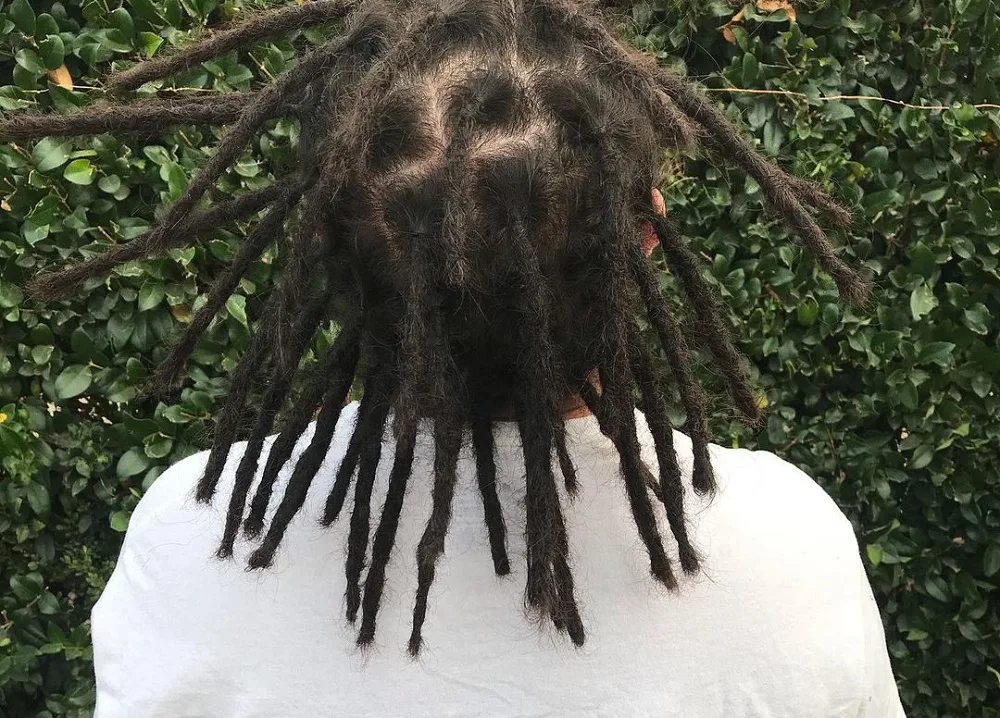Rubber bands are one of the most versatile and controversial objects that can be used when working on dreadlocks. Those tiny things can be either a great hack or a horrible experience.
The best is when you know what they’re able to do with your dreadlocks, how to use them, and what to avoid. Plus, if the method works for you.
Moving on, we’ll check the ups and downs of using rubber bands for dreads!
Pros of Rubber Band Dreads
#1. Rubber Bands Are Useful in Different Ways for Dreadlocks

Rubber bands can be used for multiple purposes like forming new dreads, tightening up the roots, holding the growth hairs together, maintaining the patterns, bounding the tips, retwist, reconstruction, combining dreadlocks to get thicker ones, or even wicks/congos/dunks, also decorating, styling, forming sections, making the pattern for crochet locs (instead of braiding cornrows), and maybe more.
In conclusion, whatever you need to do with your dreadlocks, you probably can use some rubber bands.
#2. Beginner Friendly and Can Be Done by Yourself
In general, using rubber bands for dreadlocks can be a DIY and non-invasive method of maintaining or renewing the hairstyle. It is preferred to be done by someone else, so the sections and all details can be seen clearly, but compared to other methods it may be the easiest one that can be done by yourself.
Thus, if you have dreadlocks and you plan to go to a desert island for a long time, a bunch of rubber bands can help you turn back with a great hairstyle.
It is also a beginner-friendly method of installing synthetic dreadlocks, twists, or other crochet styles, as you don’t need to know how to braid.
#3. More Control when Combining Dreads
When you use rubber bands in order to get thicker dreadlocks, wicks, congos, or dunks, you can see the entire new style before becoming permanent.
You can also try it only as a temporary hairstyle (if you take the rubber bands off before the dreads start to bind together).
#4. Quick and Affordable Installation

The procedure is way quicker and cheaper than other methods of maintaining or reconstructing dreads. However, the final result does not come right after the procedure is done.
#5. No Pain
No matter what the purpose is, when you use rubber bands on dreadlocks, there should be no pain. Try to soak the rubber bands in oil before using them, so they will not be too sticky. Also, don’t tighten them too much, the effect will be way worse if you do so.
It should be easy to break them when you want to take them off, but you can also use scissors. Removing or replacing them is absolutely necessary, otherwise, they will lock into your locs.
Cons of Rubber Band Dreads
#1. You Need to Wait for The Final Result
When using rubber bands in order to bind the roots or the tips of your dreads, or reconstruct them by gathering together groups of dreadlocks, you need to let the rubber bands in place for up to two weeks, and depending on the hair type the effect can be satisfying or not (so you need to replace them again).
You just help your dreadlocks form by themself by setting up some limits and directions.
#2. You Must Replace the Rubber Bands
If you keep the rubber bands on your dreadlocks for too long, they will embed into your dreadlocks and it will be impossible to remove them without damaging your dreads.
You need to keep an eye on them and remove or replace the rubber bands before they stick into your dreads. They can also break by themselves before doing their job.
#3. They Can Damage Your Hair

If the rubber bands are too tight, they can be painful if placed at the root, harmful, and can destroy all the aspects of your dreadlocks, including the aspect.
They would thin up the spot where placed or underneath, would break your hair, and so on. Take them off and have another try, it must feel quite comfy and shouldn’t look thinner than you expect the dread to be.
Moreover, they can also get melted, so check the temperature and don’t let them blend in.
On the other hand, if the rubber bands are too loose, they can slide off and would not be effective. There is no damage but a waste of time.
After all, rubber bands can be great tools for dreads when they are carefully used. There are lots of people who successfully manipulated their dreadlocks with the help of rubber bands.
Whether this is or isn’t for you, I hope that was good to know!
FAQs on Rubber Band Dreads
They should be removed or replaced before they start to stick inside the dreads. For that reason, it is recommended not to keep them for more than two weeks, and also to be soaked in oil before installing them, so they will be less sticky.
If installed or removed improperly, they can damage and break your hair, yes.
Yes, you can use rubber bands on any hair type, but don’t tighten them too much, and keep an eye on them so you can remove them before they get stuck into your dread.
